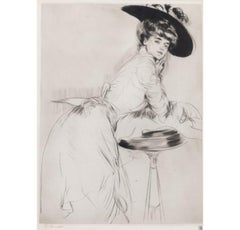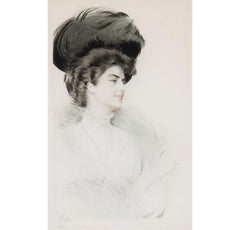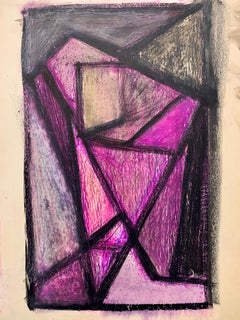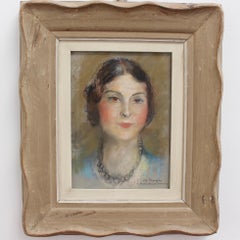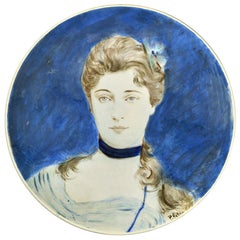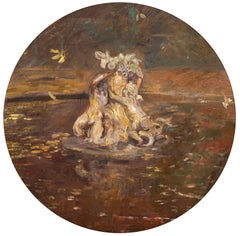Paul César Helleu Paintings
French, 1859-1927
Rich impression with dramatic drypoint burr and tone no other artist epitomizes the whole atmosphere of elegance and hedonistic pleasure which pervaded Paris society at the first decade of the century as does Helleu. A close friend of Proust and the inspiration for one of the principal characters in La Recherche du Temps Perdu, Helleu’s whole life style echoed the incomparable elegance and flow of his drawing, the sheer style of his art, and his eye for the poses of the beautiful women who were his friends and his patrons. During the 1870’s, Helleu had come to know the painters of Impressionism and also artists Sargent and Whistler who became his special friends and inspiration. By the early 1880’s, he had already developed the quality of expressive sweeping line, which is the essence of his drawing, but in 1885 he was encouraged by Tissot to try working on prints in drypoint. At this time, Tissot had decided, after the death of his lover and model Kathleen Newton, to travel to the Holy Land on an artistic pilgrimage. Having decided he would no longer engrave, he gave Helleu his diamond stylus…a literal and figurative “passing of the baton”. It was in the incision and texture of drypoint that his art was to reach one of its greatest peaks. He had an innate feel for the balance between a lightly curving stroke and the deeply cut highly tonal burr of the strongest drypoint. Around the turn of the century he started to combine drypoint with multi-inking in colors, the areas of color restricted to such touches as the bows on the hats, the hair color or the red of the lips. The plate was drawn at a single sitting, and then the color inks were brushed onto it. The results are some of the most splendid and decorative of all Belle Époque prints.to
2
2
1
Overall Width
to
Overall Height
to
1
2
1
3
3
3
2
2
1
1
1
2
2
2
2
1
24
788
695
656
572
3
3
Artist: Paul César Helleu
Leaning on a Pedestal
By Paul César Helleu
Located in Naples, Florida
Leaning on a Pedestal
Paul-César Helleu (1859-1927)
JEUNE FEMME EN BUSTE, DE PROFIL À DROITE
Black drypoint, circa 1900, on wove paper, signed and annotated 29 in pencil, with full ...
Category
Early 20th Century Paul César Helleu Paintings
Materials
Paper, Drypoint, Etching
La femme aux fleurs (Portrait de Mathilde See)
By Paul César Helleu
Located in New Orleans, LA
Paul César Helleu is regarded among the most sought-after society portraitists of his era, and his Belle Époque works rival those of his contemporaries John Singer Sargent and Giovanni Boldini. He is best remembered for capturing the era's most beautiful socialites, including Consuelo Vanderbilt, the Duchess of Marlborough, the Comtesse de Loriol Chandieu and the Comtesse Mathieu de Noailles, among others. This work, however, stands out in that it captures the charming likeness of one of his art world cohorts, Mathilde See, a Parisian-born decorator and painter of floral still lifes. She is the essence of the modern woman, captured in her fashionable dress as she strolls along the flower-lined streets of Paris.
Commanding in size, Portrait de Mathilde See fully displays Helleu's mastery over the medium of pastel. The muted palette of greys and blues is typical of the artist, bringing a harmony and cohesiveness to the composition. Furthermore, Helleu cleverly alludes to See's own artistic output with a backdrop of vibrant floral blooms, enlivening the canvas and complementing the greens and blues of the peacock feather adorning her hat.
The portrait is all the more significant thanks to its provenance. It was previously in the collection of A. Alfred Taubman, one of America's most successful entrepreneurs and one-time owner of Sotheby's. Considering Taubman encountered some of the most noteworthy and beautiful works of art ever made through his auction house, the fact that he chose this portrait by Helleu to grace his collection is a testament to its import.
Born in Brittany in 1859, Helleu moved to Paris in 1876 in order to study at the École des Beaux-Arts. Like so many other artists of his generation, he was trained there under the Academic master Jean-Léon Gérôme. That same year, he also attended the Second Impressionist Exhibition...
Category
20th Century Modern Paul César Helleu Paintings
Materials
Linen, Pastel
Bust of a young woman in profile
By Paul César Helleu
Located in Naples, Florida
Bust of a young woman in profile
Paul-César Helleu (1859-1927)
JEUNE FEMME EN BUSTE, DE PROFIL À DROITE
Color drypoint, circa 1900, on wove paper, signed and annotated 29 in pencil,...
Category
19th Century Paul César Helleu Paintings
Materials
Paper, Drypoint, Etching
Related Items
1950s "Purple Head" Mid Century Oil and Pastel Portrait Original Drawing
By Donald Stacy
Located in Arp, TX
Donald Stacy
"Purple Head"
c.1950s
Gouache and oil pastel on paper
13.75" x 17" unframed
Unsigned
Came from artist's estate
Donald Stacy (1925-2008) New Jersey
Studied: Newark School of Fine Art
The Art Students League
Pratt Graphic Arts Center
University of Paris 1953-54
University of Aix-en-Provence 1954-55
Faculty: Art Department of the New School
Museum of Modern Art
School of Visual Arts
Stacy Studio Workshop
Exhibitions: Grand Central Moderns
George Wittenborn
The New School
Print Exhibitions, Chicago
University of Oklahoma
Honolulu Museum
Monclair Museum
Wisconsin State College
Louisiana Art Commission
Philadelphia Print...
Category
Mid-20th Century American Modern Paul César Helleu Paintings
Materials
Paper, Oil Pastel, Gouache
Portrait of Woman in Pearl Necklace
By Charles Camoin
Located in London, GB
'Portrait of Woman in Pearl Necklace', pastel on fine art paper (see information below), by Charles Camoin (circa 1920s) dedicated to Marie-Louise Tavernier. Regrettably, research on...
Category
Early 20th Century Expressionist Paul César Helleu Paintings
Materials
Paper, Pastel
The Cabaret Dancer
Located in London, GB
'The Cabaret Dancer', crayon on art paper, by Kolomon Moore (circa 1930s). The Crazy Years (les Années Folles) of Paris in the 1920s hit an abrupt end in...
Category
1930s Paul César Helleu Paintings
Materials
Paper, Crayon
18th Century Pastel Portrait of a Gentleman
Located in Cotignac, FR
Late 18th Century pastel portrait on paper of a bearded gentleman. Presented under glass in a fine period gilded carved wood frame.
A cha...
Category
Late 18th Century Rococo Paul César Helleu Paintings
Materials
Paper, Pastel
Portrait Of A Young Girl In A Lilac Dress With A Black Bow. Circa 1860. SIgned.
Located in Firenze, IT
Portrait of a young girl in a lilac dress with a black bow.
Circa 1860.
Signature below right, partially visible.
Size with frame 59cm x 49cm
Size without frame 33cm x 24cm
The portrait depicts a young girl with an elegant hairstyle, her hair carefully tied back. Dressed in the fashion of the 1860s, her light lilac dress reflects the synthetic aniline colors, a novelty in fashion at the time.
A black bow at the neck and slightly black straps accentuate her attire.
Represented at mid-length, with a mysterious and melancholic gaze, suggesting a mourning endured over a year ago.
The portrait, executed in pastels, chalks, and charcoals on paper, highlights the mastery and speed of the artist's execution.
Framed in a vintage oval frame...
Category
Mid-19th Century Realist Paul César Helleu Paintings
Materials
Paper, Chalk, Crayon, Carbon Pencil
H 23.23 in W 15.36 in D 1.19 in
19th Century Academic Crayon on Paper Study by Follower of Jacques-Louis David
Located in Cotignac, FR
A fine French academic study sketch on paper of a classical head. The work is unsigned but very much in the style of the period and its early exponents such as Jacques-Louis David.
...
Category
19th Century Paul César Helleu Paintings
Materials
Paper, Crayon, Pencil, Chalk, Pastel
H 13.19 in W 10.63 in D 0.6 in
French Art, Rococo, Portrait Queen Marie Antoinette France, Oval, Circle Vivien
Located in Greven, DE
French School, Portrait of Queen Marie Antoinette of France, Pastel /oil Pastel on Paper, Rococo, 18th Century. The Pastel is made in the style...
Category
18th Century Rococo Paul César Helleu Paintings
Materials
Paper, Pastel, Oil
Jimi Hendrix. original painting
Located in Zofingen, AG
In this vibrant portrayal, I've merged multiple art styles to capture an explosion of emotions. By layering acrylics, watercolors, and colored pencils, I've created a textured harmon...
Category
2010s Pop Art Paul César Helleu Paintings
Materials
Acrylic, Oil Pastel, Archival Paper
French Art Deco Society Portrait, Beauty in a Hat. Pastel and Crayon.
Located in Cotignac, FR
A French art deco pastel portrait by Louis-Jean Beaupuy. The work is signed and dated bottom right. Presented in carved and gilded wood frame.
Beaupuy has captured all the charm and...
Category
Mid-20th Century Art Deco Paul César Helleu Paintings
Materials
Paper, Crayon, Pastel
H 27.96 in W 21.66 in D 0.79 in
French Art, Rococo Portrait, Oval, Pastel, Portrait of a Lady, Circle of Vivien
Located in Greven, DE
French School, Portrait of a Lady, Rococo, 18th Century, Fine drawing in Pastel/ Oil Pastel on Paper in the style of Vivien. The Lady might be a woman from Marie Antoinette's Court. It is part of a Pendant (see the other listing with the portrait of Queen Marie Antoinette...
Category
18th Century Rococo Paul César Helleu Paintings
Materials
Paper, Oil Pastel, Gouache
'The Red Headdress' by W. Worms
Located in London, GB
'The Red Headdress', pastel on art paper, by W. Worms (circa 1960s). A beautiful woman with contemplative expression and tender eyes is exquisitely portrayed by the artist. The treat...
Category
1960s Modern Paul César Helleu Paintings
Materials
Paper, Pastel
CHILD - Alfonso Grassi Pastel on paper Portrait italian Painting
By Alfonso Grassi
Located in Napoli, IT
CHILD - Pastel on paper cm.51x41 signed lower right by Alfonso Grassi, Italy.
Wooden frame with passeportout cm.94x73
Category
Late 20th Century Old Masters Paul César Helleu Paintings
Materials
Paper, Pastel
Previously Available Items
Large circular dish decorated by Paul Helleu with a portrait of his future wife
By Paul César Helleu
Located in PARIS, FR
This sumptuous dish, inspired by the bellas of the Italian Renaissance, is a testimony to the fruitful cooperation that began in 1882 between the ceramist Théodore Beck and the young artist Paul Helleu, before the latter became the fashionable portraitist of feminine elegance. This portrait, probably made after a photograph, could be inspired by Alice Louis-Guérin, the woman who became his wife in 1886.
1. Paul Helleu
In 1913 Robert de Montesquiou wrote in his book devoted to the painter: "Helleu was born in Vannes in 1859, of a Breton father and a Parisian mother". He hardly knew his father, who died when he was three years old, and was brought up entirely by his mother, who sent him to continue his studies at the Lycée Chaptal in Paris in 1873.
The discovery of Edouard Manet's Chemin de Fer at the 1874 Salon is reported to be at the origin of his artistic vocation. He worked against his mother's wishes in the studio of the painter Gérôme, also frequented by the painters Giovanni Boldini, Jean-Louis Forain and Antonio de La Gandara. Helleu became friends with John Singer Sargent, with whom he shared a studio for some time, as well as with Claude Monet (1840 - 1926) and Jacques Blanche (1861 - 1942), who accompanied him on a trip to England during which he met the painters Whistler and James Tissot.
When his mother cut off his pension to divert him from painting, Helleu worked in the workshop of the ceramist Théodore Deck, where he decorated ornamental ceramic medallions with women’s faces to pay for his studies at the Paris School of Fine Arts.
In 1884, the Louis-Guérin household commissioned him to paint a portrait of their daughter Alice, aged 14, which was to appear in the Salon of 1885 . Helleu fell madly in love with his model and wished to marry her. Her parents agreed to the wedding subject to three conditions: that it should only take place when Alice turned 16 (!), that she should finish her studies and that the newlyweds should live with them for two years.
From 1886 onwards, a series of happy events and successes followed: his marriage, followed by the birth of his first daughter Ellen in 1887, the participation in the Pastelists' Salon and the first exhibition of his drypoints in New York in 1889. His friendship with Robert de Montesquiou, whom he met in 1887, opened him the doors of the Parisian aristocracy. In 1891 he painted a series of portraits of Montesquiou’s cousin, the Countess Greffulhe, before meeting Marcel Proust in 1895, also thanks to Montesquiou. Proust took much of his inspiration from Helleu for the character of the painter Elstir in A la Recherche du Temps Perdu, a character whose name is said to be a clever alchemy between the names of Helleu and Whistler.
Helleu by then was at the peak of his art and multiplied female portraits, alternating between drypoint, pastels, three-colour pencil drawings whose technique had been inspired by Watteau's, and oil paintings. Commissions for his women’s portraits came from the Parisian High Society as well as from England and the United States, allowing the painter to choose his models.
In parallel to this career as a portrait painter, Helleu produced two large series of paintings concomitantly to Claude Monet's own artistic researches. Since their meeting in 1876, Monet had become a great friend of Helleu (despite an age difference of almost twenty years), and Helleu was one of the two witnesses (the other being the painter Gustave Caillebotte) when Monet, having become a widower, remarried Alice Hoschedé in 1892.
Helleu’s first series was the Cathedrals series, which he began in 1892. While Monet worked in front of the Rouen Cathedral, scrutinising from a fixed point the play of light on the portal, hour after hour and day after day, Helleu was interested in the representation of the cathedrals’ interiors and in particular in the diffusion of light from the stained-glass panels. In 1894 he began outdoor paintings in the park of Versailles. In the description of our painting, we will see how this series can be related to Monet's Water Lilies.
Thanks to his success, Helleu became a real dandy and devoted himself to his passion for yachting. His taste in interior decoration had a lasting influence, since it was Helleu who came up with the idea of abandoning the dark decorations...
Category
1880s Art Nouveau Paul César Helleu Paintings
Materials
Enamel
Autumn in Versailles - painting by Paul César Helleu an Impressionist Painter
By Paul César Helleu
Located in PARIS, FR
This tondo was executed by Helleu around 1895 in autumn leave colours. It was painted in close proximity to Monet at a time when he was about to revolutionise painting with the Water Lilies (Nymphéas). This painting reveals a little-known yet tremendously innovative aspect of Helleu’s work.
1. Paul Helleu
In 1913 Robert de Montesquiou wrote in his book devoted to the painter: "Helleu was born in Vannes in 1859, of a Breton father and a Parisian mother". He hardly knew his father, who died when he was three years old, and was brought up entirely by his mother, who sent him to continue his studies at the Lycée Chaptal in Paris in 1873.
His discovery of Edouard Manet's Chemin de Fer at the 1874 Salon is reported to be at the origin of his artistic vocation. He worked against his mother's wishes in the studio of the painter Gérôme, also frequented by the painters Giovanni Boldini, Jean-Louis Forain and Antonio de La Gandara. Helleu became friends with John Singer Sargent, with whom he shared a studio for some time, as well as with Claude Monet (1840 - 1926) and Jacques Blanche (1861 - 1942), who accompanied him on a trip to England during which he met the painters Whistler and James Tissot.
When his mother cut off his pension to divert him from painting, Helleu worked in the workshop of the ceramist Théodore Beck, where he decorated ornamental ceramic medallions with women’s faces to pay for his studies at the Paris School of Fine Arts.
In 1884, the Louis-Guérin household commissioned him to paint a portrait of their daughter Alice, aged 14, which was to appear in the Salon of 1885 . Helleu fell madly in love with his model and wished to marry her. Her parents agreed to the wedding subject to three conditions: that it should only take place when Alice turned 16 (!), that she should finish her studies and that the newlyweds should live with them for two years.
From 1886 onwards, a series of happy events and successes followed: his marriage, followed by the birth of his first daughter Ellen in 1887, the participation in the Pastelists' Salon and the first exhibition of his drypoints in New York in 1889. His friendship with Robert de Montesquiou, whom he met in 1887, opened him the doors of the Parisian aristocracy. In 1891 he painted a series of portraits of Montesquiou’s cousin, the Countess Greffulhe, before meeting Marcel Proust in 1895, also thanks to Montesquiou. Proust took much of his inspiration from Helleu for the character of the painter Elstir in A la Recherche du Temps Perdu, a character whose name is said to be a clever alchemy between the names of Helleu and Whistler.
Helleu by then was at the peak of his art and multiplied female portraits, alternating between drypoint, pastels, three-colour pencil drawings whose technique had been inspired by Watteau's, and oil paintings. Commissions for his women’s portraits came from the Parisian High Society as well as from England and the United States, allowing the painter to choose his models.
In parallel to this career as a portrait painter, Helleu produced two large series of paintings concomitantly to Claude Monet's own artistic researches. Since their meeting in 1876, Monet had become a great friend of Helleu (despite an age difference of almost twenty years), and Helleu was one of the two witnesses (the other being the painter Gustave Caillebotte) when Monet, having become a widower, remarried Alice Hoschedé in 1892.
Helleu’s first series was the Cathedrals series, which he began in 1892. While Monet worked in front of the Rouen Cathedral, scrutinising from a fixed point the play of light on the portal, hour after hour and day after day, Helleu was interested in the representation of the cathedrals’ interiors and in particular in the diffusion of light from the stained-glass panels. In 1894 he began outdoor paintings in the park of Versailles. In the description of our painting, we will see how this series can be related to Monet's Water Lilies.
Thanks to his success, Helleu became a real dandy and devoted himself to his passion for yachting. His taste in interior decoration had a lasting influence, since it was Helleu who came up with the idea of abandoning the dark decorations...
Category
1890s Impressionist Paul César Helleu Paintings
Materials
Oil
Parisian Elegant
By Paul César Helleu
Located in Marlow, Buckinghamshire
A fantastic opportunity to procure this beautiful oil on canvas by the prominent painter Paul César Helleu. A remarkable portrait of a French aristocratic women and interior.
Pau...
Category
Early 1900s Impressionist Paul César Helleu Paintings
Materials
Canvas, Oil
Paul César Helleu paintings for sale on 1stDibs.
Find a wide variety of authentic Paul César Helleu paintings available for sale on 1stDibs. You can also browse by medium to find art by Paul César Helleu in crayon, fabric, linen and more. Much of the original work by this artist or collective was created during the 20th century and is mostly associated with the modern style. Not every interior allows for large Paul César Helleu paintings, so small editions measuring 49 inches across are available. Customers who are interested in this artist might also find the work of Raymond Debieve, Marc Chagall, and Etienne Ret. Paul César Helleu paintings prices can differ depending upon medium, time period and other attributes. On 1stDibs, the price for these items starts at $425,000 and tops out at $425,000, while the average work can sell for $425,000.
